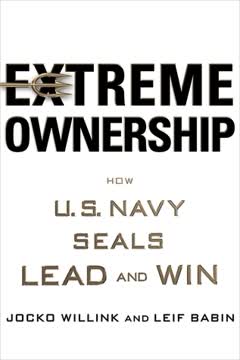Key Takeaways
1. Build Trust Through Authentic Leadership and Open Communication
"Trust as a motivator is better than fear of discipline, but neither one is as good as making it clear to your people why the job is necessary."
Transparent communication is the foundation of trust. Leaders must clearly explain the reasons behind decisions and tasks, connecting them to the bigger picture. This approach not only motivates team members but also fosters a sense of ownership and purpose.
Create an open-door policy that encourages feedback and honest dialogue. Regular town hall meetings, one-on-one sessions, and anonymous suggestion systems can provide valuable insights and demonstrate your commitment to listening. Remember, trust is a two-way street – by trusting your team with information and responsibility, you earn their trust in return.
2. Empower Your Team by Delegating Authority and Fostering Collaboration
"Collaboration was to be a top priority, I said, and when it came time to rank them, one of my main criteria would be how well they supported the other departments."
Delegate meaningful responsibilities to your team members, allowing them to grow and take ownership of their work. This not only develops their skills but also frees you to focus on strategic leadership.
Encourage cross-departmental collaboration by:
- Setting up interdisciplinary project teams
- Rewarding cooperative efforts
- Creating shared goals and metrics
- Facilitating regular inter-team meetings and knowledge-sharing sessions
By breaking down silos and fostering a collaborative environment, you tap into the collective intelligence of your organization and drive innovation.
3. Create a Culture of Excellence Through Continuous Learning and Innovation
"We learn from our failures. To me, standing in the box and swinging away is what we're here for."
Cultivate a growth mindset within your organization by encouraging experimentation and viewing failures as learning opportunities. Establish a culture where taking calculated risks is celebrated, not punished.
Implement continuous learning initiatives:
- Regular skill-building workshops and training sessions
- Mentorship programs pairing experienced staff with newcomers
- Cross-training opportunities to broaden skill sets
- Innovation challenges to solve real organizational problems
Remember, a culture of excellence is not about perfection, but about constant improvement and adaptation.
4. Lead by Example: Your Actions Speak Louder Than Words
"A leader's main function is to set the right example; what you do is far more important and instructive than what you say."
Embody the values and behaviors you expect from your team. If you want your crew to be punctual, be the first to arrive. If you preach work-life balance, demonstrate it by respecting off-hours and taking vacations.
Be mindful of the "wake" you leave behind:
- Your mood and attitude set the tone for the entire team
- How you handle stress and setbacks influences your team's resilience
- Your treatment of others, regardless of rank, shapes the organizational culture
Remember, as a leader, you're always on stage. Your team is constantly watching and learning from your actions.
5. Navigate Risks Wisely: Calculate Odds and Have Backup Plans
"Good leaders always calculate the odds and minimize the risk by having backups in place. Above all, they never take a risk that doesn't offer a worthwhile reward."
Assess risks systematically by considering potential outcomes, probabilities, and impacts. Use tools like risk matrices or decision trees to visualize and evaluate options.
Develop robust contingency plans:
- Identify potential failure points and create mitigation strategies
- Cross-train team members to ensure critical functions are covered
- Maintain open lines of communication with stakeholders
- Regularly review and update risk assessments as situations evolve
Remember, the goal is not to avoid all risks, but to take calculated risks that align with your strategic objectives.
6. Clarify Your Mission and Core Values to Unify Your Team
"Sometimes the thing that needs clarifying is simply how to win."
Articulate a clear and compelling mission that gives meaning to your team's work. Ensure that every team member understands how their role contributes to the larger purpose.
Reinforce core values through:
- Regular communication and storytelling that highlights values in action
- Recognition programs that reward behaviors aligned with core values
- Decision-making processes that explicitly consider alignment with values
- Onboarding and training programs that emphasize organizational culture
A well-defined mission and strong core values provide a north star for your team, guiding decisions and behaviors even in uncertain times.
7. Inspire and Motivate Through Recognition and Meaningful Work
"The more I thanked them, the harder they worked."
Implement a robust recognition system that acknowledges both big wins and small victories. This can include formal awards, public praise, or simple thank-you notes. The key is to make recognition specific, timely, and genuine.
Create opportunities for meaningful work:
- Connect individual tasks to the larger organizational mission
- Provide autonomy in how work is accomplished
- Offer stretch assignments that challenge and develop skills
- Encourage employees to pursue passion projects that benefit the organization
Remember, intrinsic motivation – the sense of purpose and accomplishment – is often more powerful than extrinsic rewards.
8. Embrace Failure as a Learning Opportunity and Encourage Risk-Taking
"We had learned to win by learning about losing. We had learned that failure beats you only if you let it."
Create a psychologically safe environment where team members feel comfortable taking calculated risks and reporting mistakes. This openness allows for early problem detection and correction.
Transform failures into learning experiences:
- Conduct thorough post-mortems focused on improvement, not blame
- Share lessons learned across the organization to prevent repeat mistakes
- Celebrate "intelligent failures" that result from well-reasoned risks
- Use failures as teaching moments to refine processes and strategies
By reframing failure as a stepping stone to success, you encourage innovation and resilience in your team.
9. Cultivate a Diverse and Inclusive Environment to Maximize Potential
"Treat your people with respect, regardless of their rank."
Actively seek out diverse perspectives when building teams and making decisions. Diversity in backgrounds, experiences, and thinking styles leads to more creative problem-solving and robust strategies.
Foster an inclusive culture by:
- Providing unconscious bias training to all team members
- Establishing mentorship programs that support underrepresented groups
- Ensuring equitable access to opportunities and resources
- Creating affinity groups to give voice to diverse perspectives
Remember, diversity without inclusion is merely tokenism. True inclusion means valuing and leveraging the unique contributions of every team member.
10. Balance Tradition with Innovation to Stay Relevant and Effective
"Tradition is no excuse for conducting business as usual when there is a better way."
Regularly assess your organization's practices to identify areas where tradition may be hindering progress. While some traditions contribute to organizational identity and cohesion, others may be outdated and inefficient.
Strike a balance between tradition and innovation:
- Preserve traditions that reinforce core values and organizational culture
- Challenge "sacred cows" by questioning why things are done a certain way
- Encourage "reverse mentoring" where junior staff share new perspectives with senior leaders
- Create innovation labs or skunkworks teams to experiment with new ideas
Remember, the goal is not to discard all traditions, but to evolve in ways that honor your organization's heritage while embracing necessary change.
Last updated:
FAQ
What's "It's Our Ship" about?
- Leadership Focus: "It's Our Ship" by D. Michael Abrashoff is a guide to leadership, emphasizing the importance of collaboration and shared ownership in achieving success.
- Navy Experience: The book draws on Abrashoff's experience as a Navy captain, particularly his time commanding the USS Benfold, to illustrate effective leadership strategies.
- Evolution of Ideas: It builds on his previous work, "It's Your Ship," by shifting the focus from individual leadership to collective responsibility and teamwork.
- Practical Lessons: The book offers practical lessons and anecdotes that can be applied to both military and civilian leadership contexts.
Why should I read "It's Our Ship"?
- Proven Strategies: The book provides proven leadership strategies that transformed a struggling ship into one of the best in the Navy.
- Real-Life Examples: Abrashoff uses real-life examples and personal anecdotes to illustrate his points, making the lessons relatable and actionable.
- Focus on Teamwork: It emphasizes the importance of teamwork and shared ownership, which are crucial for success in any organization.
- Broad Applicability: The leadership principles discussed are applicable across various fields, not just in the military, making it valuable for a wide audience.
What are the key takeaways of "It's Our Ship"?
- Shared Ownership: Success is achieved when everyone takes ownership of the mission and works collaboratively.
- Empowerment and Trust: Empowering team members and building a climate of trust are essential for high performance.
- Communication and Clarity: Clear communication of goals and values is crucial for aligning the team and achieving objectives.
- Continuous Improvement: Leaders should focus on continuous improvement and learning from both successes and failures.
How does D. Michael Abrashoff define leadership in "It's Our Ship"?
- Collaborative Leadership: Leadership is about creating a sense of shared ownership and collaboration among team members.
- Empathy and Understanding: Effective leaders put themselves in the shoes of their team members to understand their perspectives and needs.
- Leading by Example: Leaders should set the right example through their actions, as this influences the behavior and attitudes of their team.
- Adaptability and Learning: Leadership involves being open to learning and adapting strategies based on feedback and changing circumstances.
What are some of the best quotes from "It's Our Ship" and what do they mean?
- "It's not your ship; it's our ship." This quote emphasizes the shift from individual to collective responsibility, highlighting the importance of teamwork.
- "Put yourself in the boss’s shoes." This advice encourages empathy and understanding, which are crucial for effective leadership.
- "Do the right thing." A reminder that ethical behavior and integrity are fundamental to building trust and respect within a team.
- "Failure beats you only if you let it." This quote underscores the importance of learning from failures and using them as stepping stones to success.
How does "It's Our Ship" build on "It's Your Ship"?
- Shift in Focus: While "It's Your Ship" focused on individual leadership, "It's Our Ship" emphasizes collective responsibility and teamwork.
- Lessons Learned: Abrashoff shares new insights and lessons learned since writing his first book, reflecting on his growth as a leader.
- Broader Perspective: The book expands the scope from leading a single ship to understanding the interconnectedness of a fleet or organization.
- Updated Strategies: It includes updated strategies and techniques that have been refined through years of experience and feedback.
What specific methods or advice does D. Michael Abrashoff offer in "It's Our Ship"?
- Empowerment: Encourage team members to take initiative and make decisions within their areas of responsibility.
- Open Communication: Maintain open lines of communication to ensure everyone is aligned with the mission and goals.
- Recognition and Praise: Regularly acknowledge and praise team members for their contributions to boost morale and motivation.
- Continuous Feedback: Provide continuous feedback and support to help team members grow and improve their performance.
How does D. Michael Abrashoff address the concept of risk in "It's Our Ship"?
- Calculated Risks: Leaders should calculate the odds and minimize risks by having backup plans in place.
- Avoid Recklessness: While taking risks is necessary, reckless actions without understanding the consequences should be avoided.
- Learning from Mistakes: Use failures as learning opportunities to improve strategies and decision-making processes.
- Encourage Innovation: Create an environment where team members feel safe to take calculated risks and innovate.
What role does trust play in leadership according to "It's Our Ship"?
- Foundation of Success: Trust is the foundation of a successful team, enabling open communication and collaboration.
- Building Trust: Leaders build trust by being consistent, transparent, and putting the interests of their team first.
- Trust and Empowerment: Empowering team members and trusting them to make decisions fosters a sense of ownership and accountability.
- Repairing Trust: When trust is broken, leaders must take immediate action to address issues and rebuild confidence within the team.
How does "It's Our Ship" suggest handling failure and setbacks?
- Learning Opportunities: View failures as opportunities to learn and improve, rather than as insurmountable obstacles.
- Encourage Resilience: Foster a culture of resilience where team members are encouraged to bounce back from setbacks.
- Analyze and Adapt: Analyze failures to understand what went wrong and adapt strategies to prevent similar issues in the future.
- Supportive Environment: Create a supportive environment where team members feel safe to take risks and learn from their mistakes.
What are some practical examples of leadership from "It's Our Ship"?
- Empowering Junior Officers: Abrashoff shares examples of empowering junior officers to take on responsibilities, boosting their confidence and skills.
- Open Communication: He describes using the ship's PA system to communicate openly with the crew, ensuring everyone was informed and aligned.
- Recognition and Praise: Abrashoff regularly praised and recognized crew members for their achievements, fostering a positive and motivated team environment.
- Innovative Solutions: The book includes examples of innovative solutions developed by the crew, demonstrating the power of collaboration and creativity.
How can the lessons from "It's Our Ship" be applied to civilian leadership?
- Team Collaboration: Encourage collaboration and shared ownership in any organization to achieve common goals.
- Empowerment and Trust: Empower employees to make decisions and trust them to carry out their responsibilities effectively.
- Clear Communication: Maintain clear and open communication to ensure everyone understands the mission and their role in achieving it.
- Continuous Improvement: Foster a culture of continuous improvement, where learning from successes and failures is encouraged.
Review Summary
Readers generally found It's Our Ship to be a valuable follow-up to Abrashoff's previous book, offering practical leadership advice and real-world examples from various industries. Many appreciated the author's humility and willingness to share his own growth. The book received praise for its straightforward approach, relatable stories, and actionable insights. Some readers noted similarities to the first book, while others found it a useful refresher. Overall, reviewers recommended it as a solid resource for both new and experienced leaders.
Similar Books









Download PDF
Download EPUB
.epub digital book format is ideal for reading ebooks on phones, tablets, and e-readers.





